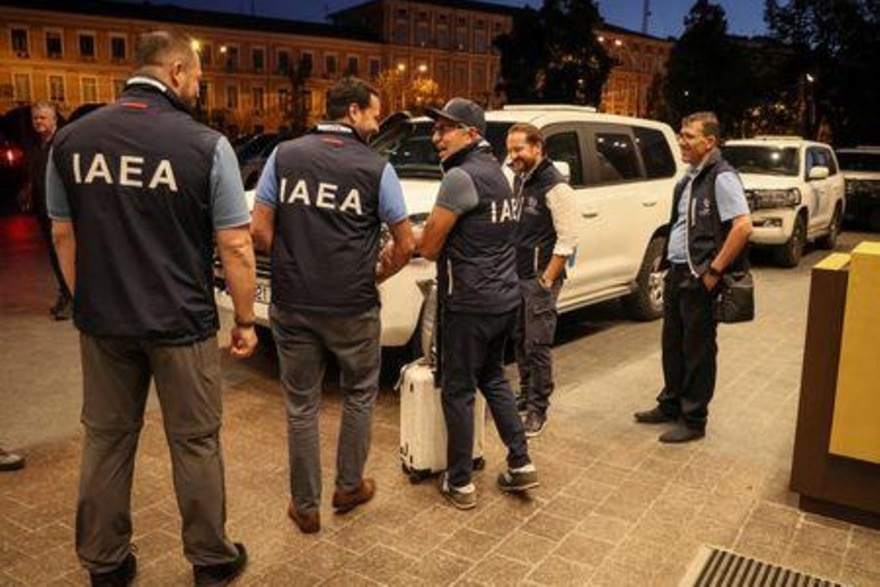KYIV, (Reuters) – U.N. nuclear inspectors set off in convoy for Ukraine’s Zaporizhzhia nuclear plant today after weeks of shelling nearby sparked fears of a Chornobyl-style radiation disaster, with tensions rising between Kyiv and Moscow over the visit.
A Reuters reporter following the team from the International Atomic Energy Agency (IAEA) from Kyiv, the Ukrainian capital, said it was likely the inspectors would overnight in the nearby city of Zaporizhzhia before visiting the plant, which is on territory controlled by Russia, on Thursday.
Russian-installed officials in the area suggested the visit might last only one day, while IAEA and Ukrainian officials suggested it would last longer.
“We are now finally moving after six months of strenuous efforts,” IAEA chief Rafael Grossi told reporters before the convoy set off, adding that the mission planned to spend “a few days” at the site.
“We have a very important task there to perform – to assess the real situation there, to help stabilise the situation as much as we can. We are going to a war zone, we are going to occupied territory and this requires explicit guarantees, not only from the Russian Federation but also from Ukraine. We have been able to secure that,” said Grossi.
Russia captured the plant, Europe’s largest, in early March as part of what Moscow calls its “special military operation”, something Kyiv and the West have described as an unprovoked invasion designed to grab land and erase Ukrainian identity.
A Russian military force has been at the plant ever since, as has most of the Ukrainian workforce who have toiled to keep the facility, which traditionally supplied Ukraine with 20 percent of its electricity needs, running.
For weeks now, Ukraine and Russia have accused each other of endangering the plant’s safety with artillery or drone strikes.
Kyiv says Russia has been using the plant as a shield to strike towns and cities, knowing it will be hard for Ukraine to return fire. It has also accused Russian forces of shelling the plant.
“The situation at the Zaporizhzhia nuclear power plant and in Enerhodar and surrounding areas remains extremely dangerous,” Ukrainian President Volodymyr Zelenskiy said late on Tuesday. “The risk of a radiation disaster due to Russian actions does not decrease for an hour.”
The Russian defence ministry has said that radiation levels at the plant are normal.
Moscow has denied Ukrainian assertions of reckless behaviour, questioning why it would shell a facility where its own troops are garrisoned as what it describes as a security detail.
Moscow has in turn accused the Ukrainians of shelling the plant to try to generate international outrage that Kyiv hopes will result in a demilitarised zone. Russia has said it has no intention of withdrawing its forces for now.
Kyiv and Moscow both claimed battlefield successes on Wednesday as Ukraine mounted a counter-offensive to recapture territory in the south. Reuters could not independently verify such reports.
Away from Ukraine, Russia halted gas supplies through the biggest pipeline to its top customer Germany, raising the prospect of recession and energy rationing in some of Europe’s richest countries going into winter.
Ukraine’s allies have accused Russia of using energy as a weapon in retaliation for Western sanctions. Moscow denies doing so and cites technical reasons for supply cuts.
Grossi said one of his priorities was to talk to the Ukrainian technicians running the plant.
“That’s one of the most important things I want to do and I will do it,” he said.
It was not immediately clear how long the inspectors would be able to remain at the power station however.
Russia said it welcomed the IAEA’s stated intention to set up a permanent mission at the plant.
But Yevgeny Balitsky, head of the Russian-installed administration in the area, told the Interfax news agency that the IAEA inspectors “must see the work of the station in one day”.
The United States has urged a complete shutdown of the plant and called for a demilitarised zone around it.
The Interfax news agency quoted a Russian-appointed local official as saying on Wednesday that two of the plant’s six reactors were running.
The plant is close to the front lines and Ukraine’s armed forces on Wednesday accused Russia of shelling a contact line in the area and of preparing to resume an offensive there.
There was no immediate comment from Moscow.
Zelenskiy in a late night address on Tuesday said Ukrainian forces were attacking Russian positions in Ukraine along the entire frontline after Kyiv announced on Monday it had launched an offensive to try to retake the south. Zelenskiy said his forces were also on the offensive in the east.
Russia captured large tracts of southern Ukraine near the Black Sea coast in the early weeks of the six-month-old war, including in the Kherson region, which lies north of the Russian-annexed Crimean Peninsula.
Ukraine sees recapturing the region as crucial to prevent Russian attempts to seize more territory further west that could eventually cut off its access to the Black Sea.

